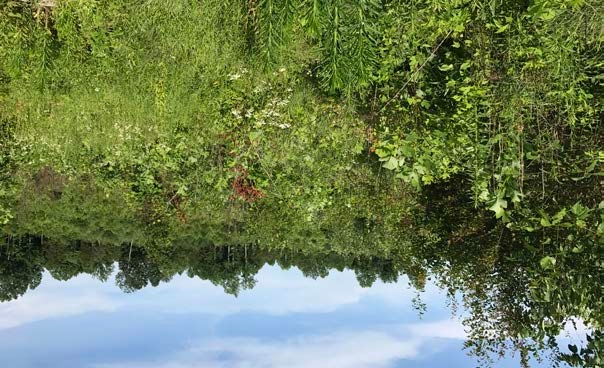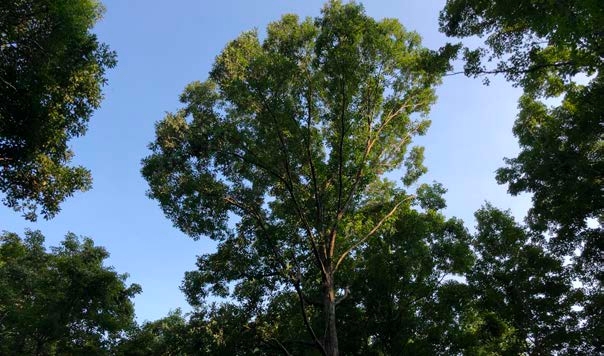Managing Your Woods for White-Tailed Deer
RESOURCES - PUBLICATIONS
Managing Your Woods for White-Tailed Deer
Authors
Jarred Brooke, Mitchell Zischke,
Fred Whitford, and Phil Cox

Introduction
Many forest landowners are interested in improving their properties for one of Indiana’s most abundant game animals, white-tailed deer. Deer are generalists and are adaptable to a wide range of habitat conditions. White-tailed deer use young and mature forests, as well as early successional areas like old fields and forest openings. These broad habitat requirements mean deer reside on most properties, even in the absence of habitat management. However, there are many forest management options landowners have to improve deer habitat on their property.
Deer habitat quality is optimized when the property contains a diverse mix of forest ages and plant communities. Forest management activities increase the amount and quality of food and cover available for deer and other wildlife species. This factsheet will describe various forest management activities you can use on your property to enhance habitat for white-tailed deer and other wildlife.
Good, Bad, or Ugly: Grading the Quality of Deer Habitat in Your Woods
The first step in determining what needs to be done to improve deer habitat is to step back and take a look at what the property has to offer. You should take note of the food and cover available to deer, and the overall condition of the habitat. Evaluating these habitat components can help determine the positive – and negative – aspects of your property and help identify limiting factors for deer. If you own a small property, it’s important to consider the quality of habitat in the surrounding landscape and how your property can be strategically improved to increase habitat quality for deer in your area.

It is important to look at the arrangement of vegetation types on your property and see how it compares to the surrounding landscape to better understand how to improve your property for deer.
Things to consider:
• What vegetation types (e.g., forest, crops, pasture, old fields) are on your property?
• What are the relative percentages of each of those vegetation types?
• What overstory trees are common in your woods?
• Are all the trees in your woods a similar size or age, or do you have a wide range of tree sizes and age?
• Are your woods part of a larger forest or are they isolated?
Once you get an overall picture of your property, you can grade the current condition of your woods in terms of deer habitat quality. Here are a few questions to see if the woods on your property makes the grade:
• Are your forested areas mostly mature closed-canopy forest?
• Is the understory of your woods bare?
• Are oaks lacking in the overstory and/or understory?
• Are there lots of sugar maple and American beech trees in the understory?
• Are invasive plants common in your woods?
If you answered yes, to any or all of these questions, then there are several ways you can improve your woods for deer. These are all signs that a lack of food and/or cover is likely limiting habitat quality for deer in your woods. If you are still unsure about the quality of your woods for deer, you should reach out to a forestry or wildlife professional to help evaluate your property.
Working with a Forestry or Wildlife Professional
Determining which management options are right for your property can be a tricky endeavor. Which tools are the right ones, is largely based on your objectives and the current condition of your woods. The best way to determine which options are right for your property is to consult a forestry or wildlife professional who can help lead you in the right direction. This could be a biologist from your state wildlife agency, a forester from your state forestry agency, or a private forestry/wildlife consultant. They will be able to help answer your questions about what strategies are best for your property and help you meet your management objectives.
They will also help you formulate a management plan that will steer you in the right direction as you move forward in improving your property. A list of forestry professionals can be found by visiting www.INforestryX.com. A list of wildlife professionals can be found by visiting
https://extension.purdue.edu/pondwildlife/.

Visiting with a forestry or wildlife professional can help evaluate your property and determine which management options fit your property and management objectives. Photo by Joel Wahlman
Forest Succession
Before we discuss forest management options to enhance deer habitat on your property, it’s first important to understand how the composition (e.g., plant and tree species) and structure (e.g., understory, midstory, and overstory) of a forest change over time. This change in the plant community over time is called plant succession. Similarly, the change in the forest plant community and forest structure is forest succession.
You have probably observed what happens after a timber harvest. Within the first year after harvest, you begin to see new plants, mainly grasses and forbs (herbaceous broadleaf plants), colonizing the area. Over the next few years, blackberries, shrubs, and trees become more common and dominate the area. Left alone, you will eventually see the site develop into a mature forest. The plant composition and the structure of a forest dictates what resources are available to white-tailed deer and other wildlife species. Deer habitat is best when there is a diversity of successional stages on your property.
EARLY SUCCESSIONAL AREAS
Early successional areas can be old fields, permanent forest openings, areas that have been edge feathered, or planted native grass and forb fields. Early successional areas are dominated by herbaceous vegetation like forbs and grasses, but can also have shrub cover. Plants like goldenrod, ticktrefoil, ragweed, brambles (blackberry and raspberry), and partridge pea are common in early successional areas.
These areas provide excellent sources of forage for deer (1,000 – 2,000 pounds per acre) and are used for fawning, bedding, and security cover. Early successional plant communities can be maintained in forested areas through the use of prescribed fire, disking, herbicide, or other disturbances. Most often, combining these techniques is necessary to best manage early successional areas. For more information about managing early successional areas for wildlife, see Purdue Extension Publication FNR-548-W Renovating Native Warm-Season Grass Stands for Wildlife: A Land Manager’s Guide.

Early successional areas that are a mix of grasses, forbs, and shrubs provide valuable food and cover for deer.
YOUNG FOREST STANDS
Young forests differ from early successional areas in that young forests are dominated by woody species - either that grow from seed or from stump sprouts. Young forests develop following a disturbance like a timber harvest, fire, tornado, or tree disease outbreak, and provide a tremendous amount of cover and forage for white-tailed deer and other wildlife species. Similar to early successional areas, deer will use these areas to find forage, hide fawns, bed, and seek refuge from weather and predators. A single acre of young forest can easily provide 600-1,000 pounds of forage for deer, depending on the composition of the plant community. Young forests that are less than 6 years old generally provide the most forage and cover for white-tailed deer.
Once a young forest reaches 10-20 years old (often sooner) the canopy has closed and the ground becomes completely shaded. When the canopy closes, forage for deer starts to diminish; forbs and brambles are shaded out and woody browse is taller than deer can reach.

Do you see all the forage and cover produced in this young forest? In this 5-year-old young forest the cover and forage are well within reach of a deer.
While these stands lack forage for deer, they may still provide cover. Once a young forest enters this stage, management is needed to increase their value for deer. Fortunately, this is the perfect time to conduct forest stand improvement to increase the quality of deer habitat as well as the quality of timber. Crop tree release and thinning are two options you can use in these stands to increase sunlight to the forest floor and give valuable (both for timber and wildlife) trees more room to grow. This can be done through hack-andsquirt (with herbicide) or girdling of undesirable trees.

The amount of food and cover available for deer decreases as a young forest closes its canopy and sunlight no longer reaches the forest floor. Thinning this stand of tulip-poplar would not only increase its value for deer, but it would increase the timber value of the remaining trees. Photo by Ron Rathfon
MATURE FOREST
Mature forests with a closed canopy often have a sparse understory, which does not provide much forage – around 50 -100 pounds per acre – or cover for white-tailed deer. The limited forage and cover results from a lack of sunlight reaching the forest floor. They do, however, provide a valuable source of hard mast (e.g., acorns) and soft mast (e.g., persimmons) for deer and other wildlife. Deer relish acorns, but they are an unreliable food source.
A good white oak acorn crop only occurs 2 out of every 5 years, and acorns are only available during the fall and winter. Thus, you cannot rely on acorns to supply enough food for deer every year or year-round. If all your forested areas have a closed-canopy, your property will be limited in the amount of food and cover available for deer. Just by reducing the canopy by 30% in a closed-canopy forest, you can substantially increase the forage and cover for deer and other wildlife while still retaining mast production.

Beyond acorns, what food and cover is available to deer in this closed-canopy mature forest? Opening up the canopy by removing some of the sugar maples would allow more sunlight and create more food and cover for deer; all while helping the oaks produce more acorns.
Forest Management for Deer
Managing forested areas for white-tailed deer is a matter of managing sunlight. Walk into a mature forest and look at the amount of vegetation growing in the understory. Often times the forest floor is nearly bare; consisting only of dense leaf litter and sparse understory vegetation. Where sunlight is captured by the tree canopy, the forest floor will have much less forage and cover as compared with gaps in the canopy that allow sunlight to the forest floor. So, how does your property rate in terms of sunlight reaching the forest floor?
Let’s focus on a few management options that you may have to ‘open up’ your woods. Many different forest management techniques can benefit deer or other wildlife species on your property, and can help you achieve your management objectives, whether it be deer, timber, or both.
These can be commercial activities like a timber harvest that provide revenue or they can be activities that are conducted outside of a timber harvest. Practices outside of a timber harvest are commonly referred to as forest or timber stand improvement.
Managing forested areas for deer is a matter of managing sunlight. The more sunlight reaching the ground, the more forage and cover is produced for deer.

The canopy in this stand has been thinned and you can already see the understory vegetation responding in the canopy gaps.
Food for Deer: Which Plants Do Deer Eat?
Much of a deer’s diet is made up of native plants, especially in heavily forested areas. During the spring and summer, forbs provide an important source of protein and nutrients when does are lactating and bucks are growing antlers. Throughout the year, many native woody plants also provide food for white-tailed deer. On the other hand, most grasses (except for some cereal grains like wheat) do not have much nutritional value for deer and are rarely consumed. Additionally, many invasive plants like multiflora rose, bush honeysuckle, and Japanese stiltgrass also do not provide good forage for deer. If deer are eating these plants on your property, then you have too many deer and/or food is in short supply!
Many of the native plants listed in the chart to the right are considered moderately or highly-selected forages for deer. Looking for some of these species on your property can help you gauge the quality of deer forage in your woods and open areas.
Native Plants Selected by Deer for Forage
| Woody plants | Forbs |
| black raspberry | American pokeweed |
| blackberry | asters (Symphyotrichum spp.) |
| blueberry | bedstraw |
| chokecherry | common ragweed |
| gray dogwood | giant ragweed |
| sumac | goldenrod |
| viburnum | jewelweed |
| wild hydranga | partridge pea |
| blackgum | tick trefoil (Desmodium spp.) |
| elm | wild lettuce |
| flowering dogwood | wood nettle |
| maples | woodland sunflower |
| oaks | |
| tulip-poplar | |
| grape | |
| greenbrier | |
| poison ivy | |
| Virginia creeper |
Native plants species like (A) Blackberry, (B) Greenbrier, (C) American pokeweed, and (d) Wild lettuce provide excellent forage and are commonly browsed by deer.
 Blackberry
Blackberry  Greenbrier
Greenbrier  American pokeweed
American pokeweed  Wild lettuce
Wild lettuce DEER AND TIMBER HARVEST
It’s a common misconception that harvesting timber is not compatible with healthy wildlife populations. But in fact, many wildlife species such as deer benefit from the young forest created following harvest. Harvesting timber can be a great way of increasing forage and cover by allowing sunlight to reach the forest floor. Harvesting timber can provide quality habitat for many wildlife species, while also providing a source of revenue that can offset the cost of other habitat management on your property (e.g., prescribed fire or food plots).
Timber can be harvested sustainably in ways that utilize different forest regeneration methods. A forest regeneration method refers to a specific strategy used to create the next generation of forest. Forest regeneration methods are commonly grouped into two categories-even-aged and uneven-aged forest regeneration. Different forest regeneration methods are used to regenerate specific species of trees. Some trees, like oaks, do not grow well under the shade of the tree canopy (shade- intolerant), whereas species like American beech do grow well under the shade of the tree canopy (shade-tolerant).
Even-aged forest regeneration
As the name implies, even-aged forest regeneration creates a forest stand that is one age class. Even-aged forest regeneration methods are designed to regenerate tree species that are less shade tolerant like oaks, hickories, black cherry, and tulip-poplar. Even-aged forest regeneration often involves removing all the trees in a single harvest, or at least the majority of the trees in a forest stand. The two most common even-aged regeneration methods are clearcut and shelterwood.
CLEARCUT
The term clearcut is often used interchangeably with the term land clearing. This is unfortunate, incorrect, and often leads to confusion. Clearcut refers to a forest regeneration method in which all trees are harvested from a forest stand, allowing new trees to take their place, thus creating a young forest. But, ultimately the area remains a forest. On the other hand, land clearing refers to removing trees from a site to change the land from a forest into some other land use like a wildlife opening, home site, subdivision, or agricultural field. That land no longer remains a forest. Thus, clearcutting and land clearing are not the same.
Clearcuts have many benefits to deer and other wildlife because of the amount of sunlight reaching the forest floor after harvest. If you have walked over such an area, you will quickly notice the flush of new vegetation that provides ample amounts of forage and cover. During the first six years after harvest, the area can produce 600-1,000 pounds of deer forage per acre per year. The increase in sunlight can also help regenerate shade-intolerant tree species. Clearcuts can range in size from a few acres to tens of acres.
Clearcuts do not have to be large to be beneficial to deer. Even clearcuts as small as a few acres can provide excellent forage and cover for deer and other wildlife species.
SHELTERWOOD
Shelterwood harvests are conducted by removing a percentage of overstory trees in a forest stand. Generally, 40% to 60% of the overstory trees are selectively removed. For instance, oaks and other mast-producing species like hickories are left in the overstory to provide a source of shade, seed for the new forest, and a food source for wildlife. This regeneration method provides the best of both worlds in terms of increased sunlight to create forage and cover for deer, while retaining oaks in the overstory to provide acorns. A shelterwood harvest can provide 200-600 pounds of forage per acre for deer.
Which Regeneration Method is Best for My Woods?
No one regeneration method is best for managing deer habitat in all situations and on all properties. This is why you need to evaluate your property, determine your specific goals, and conduct a forest inventory. The best advice for those interested in conducting a timber harvest to improve deer habitat is to reach out to a forestry or wildlife professional for assistance. A professional can help you determine the regeneration method and the size, shape, and location of a harvest that fits your woods and your objectives.
This regeneration method is beneficial for regenerating many tree species that are less shade tolerant and is often used to regenerate oaks. The remaining overstory trees are harvested at a later date once young oak trees have been established. Harvesting the remaining overstory trees helps provide room and sunlight for the young trees and other vegetation to grow. Shelterwood harvests provide both forage and cover for deer, while also providing acorns during fall and winter.
Uneven-aged forest regeneration
Uneven-aged management creates a forest stand with multiple age classes. This type of management generally promotes shade-tolerant tree species like sugar maple and American beech, unless large enough canopy gaps are created to increase sunlight to the forest floor. Only a few trees per acre are removed at any given time and those trees are taken either throughout the stand or in small groups. Single-tree selection and group selection are the two most common types of uneven-aged management.
SINGLE-TREE SELECTION
Single-tree selection is a regeneration method where single trees are harvested at certain spacing throughout a forest stand. This method provides the least disturbance to the forest canopy and maintains a relatively mature forest with multiple ages.
Single-tree selection promotes shade-tolerant species as opposed to shade-intolerant species. From the standpoint of deer habitat quality, this method often does not substantially increase forage and cover. Removing a tree here and there does not greatly increase the amount of sunlight reaching the forest floor. Increasing the number of trees removed throughout the stand will increase the amount of sunlight to the ground and create better deer habitat. A stand that has been harvested with single-tree selection may produce the same amount or slightly more forage per acre (approximately 75-125 pounds per acre) compared to an unharvested mature forest.

Figure 1. Forage production following various forest regeneration methods in southern Indiana forests.
GROUP SELECTION
Group-selection represents a good intermediary between single-tree selection and clearcut. In this method, groups of trees in 1-2 acre blocks or smaller are removed to create a larger gap in the canopy. Forage and cover will flourish within these regeneration openings. The group-selection method can be used to regenerate shade-intolerant species or some species of intermediate shade tolerance – depending on size of gap created. Group selection harvests can produce 300-500 pounds of deer forage per acre. This method is a great tool on small tracts of forest land where canopy gaps do not exist, and the landowner is interested in improving the forage and cover for deer and other wildlife. Regeneration openings from group selection harvests can be created in different areas across a property over multiple years to ensure there is always an abundance of forage and cover available for deer and other wildlife.
TIMBER HARVEST Even-aged regeneration
CLEARCUT
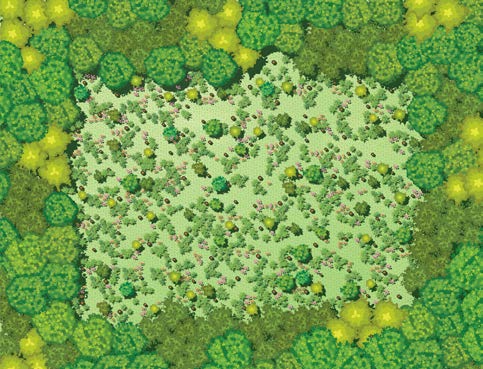 White-Tailed Deer Habitat Benefits
White-Tailed Deer Habitat Benefits
| Deer Forage (lbs per acre)1 |
Overall Benefits |
| 600 - 1000 | • Increased forage and browse • Increased fawning, escape, and thermal cover |
| Other Wildlife Benefits | Forest Benefits |
| • Creates habitat needed by young forest wildlife (ruffed grouse, American woodcock, blue-winged warbler, whip-poor-will) | • Promotes regeneration of shade-intolerant species (oak, tulip-poplar, cherry) |
| • Increases forage, browse, and soft mast | • Creates young forest |
| • Tree tops and downed logs left on site provide cover for wildlife |
SHELTERWOOD
 White-Tailed Deer Habitat Benefits
White-Tailed Deer Habitat Benefits
| Deer Forage (lbs per acre)1 |
Overall Benefits |
| 200 - 600 | • Increased forage and browse • Increased fawning, escape, and thermal cover • Retain mast production (acorns) from overstory trees |
| Other Wildlife Benefits | Forest Benefits |
| • Creates habitat needed by young forest wildlife (grouse, woodcock, blue-winged warbler, whip-poor-will) | • Promotes regeneration of shade-intolerant species (oak, tulip-poplar, hickory, cherry) |
| • Increases forage, browse, and soft mast | • Retains a source of seed from overstory trees |
| • Tree tops and downed logs left on site provide cover for wildlife | • Creates young forest |
| • Retains important mast producing species |
TIMBER HARVEST Uneven-aged regeneration
SINGLE-TREE SELECTION
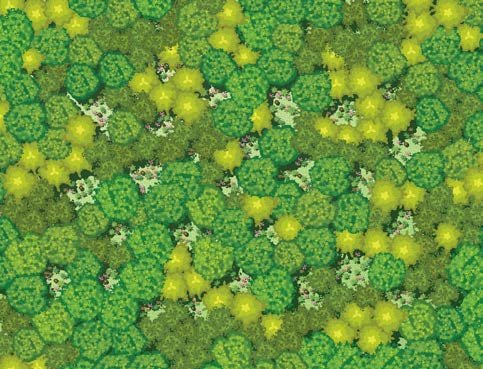 White-Tailed Deer Habitat Benefits
White-Tailed Deer Habitat Benefits
| Deer Forage (lbs per acre)1 |
Overall Benefits |
| 75 - 125 | • Retains mast-producing trees in the overstory |

| Other Wildlife Benefits | Forest Benefits |
| • Provides habitat for wildlife that need mature forest | • Promotes regeneration of shade-tolerant species (beech, maple) |
| • Retains important mast producing species in overstory | • Maintains mature forest |
| • Tree tops left of site provide cover for wildlife |
GROUP SELECTION
 White-Tailed Deer Habitat Benefits
White-Tailed Deer Habitat Benefits
| Deer Forage (lbs per acre)1 |
Overall Benefits |
| 300 - 500 | • Increased forage and browse • Increased fawning, escape, and thermal cover |
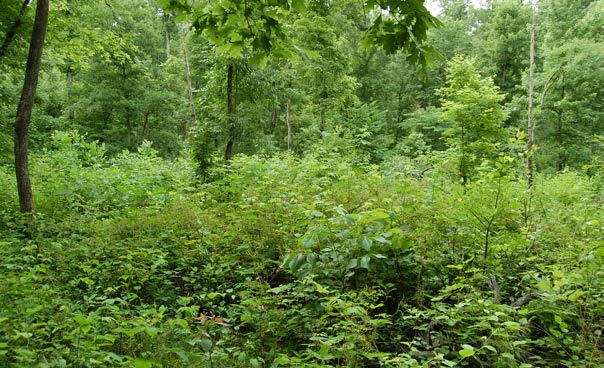
| Other Wildlife Benefits | Forest Benefits |
| • Provides habitat for species that utilize both mature forest and young forest (e.g., ruffed grouse and cerulean warbler) | • Can regenerate small patches of shade-intolerant tree species like oaks |
| • Increased forage, browse, and soft mast | • Creates diversity of forest age classes including young forest |
| • Tree tops and downed logs left on site provide cover for wildlife |
FOREST STAND IMPROVEMENT: BEYOND TIMBER HARVEST
Many forest management options called timber or forest stand improvement exist outside of timber harvest and can be utilized to improve deer habitat and/or timber quality. Forest stand improvement are practices that improve the quality, composition, and structure of a forest to meet specific objectives; in this case the objective is to improve deer habitat. These practices are often used when merchantable timber is absent, the trees onsite are of poor quality, too young to harvest, or when generating timber income is not a top priority. From a wildlife perspective, forest stand improvement often involves removing trees of lower wildlife value (maple, ash, ironwood, sycamore, etc.) to favor hard- and soft-mast producing species of higher wildlife value (oak, hickory, dogwood, persimmon, blackgum). Some examples of forest stand improvement would be thinning, prescribed fire, edge feathering, and crop tree or crown release.
For more information about forest stand improvement check out the Purdue Extension Publication FNR-IDNR-414: Forest Improvement Handbook.
Wildlife retention cut: thinning for wildlife
Thinning forest stands can be a great way to increase the sunlight to the forest floor, thus providing increased forage and cover for deer, while also improving forest composition, structure, and growth. Removing as little as 30% of the canopy can create enough sunlight to double the amount of forage available for deer. Thinning can be done in multiple ways, but to improve wildlife habitat, the first step is removing trees that are less desirable for wildlife and retaining tree species that are more desirable, hence the name wildlife retention cut. This method is similar to what foresters refer to as an improvement cut, but here our objective is wildlife not timber.
Wildlife retention cuts are similar to shelterwood harvests in that some trees are removed from the overstory, but most mast-producing trees are retained. The aim should be to leave a variety of hard and soft mast producing trees (e.g., oak, hickory, blackgum, dogwood, and persimmon). Those selected trees remaining in the forest stand will have more sunlight reaching the crown allowing them to expand and, in some years, produce more mast. Undesirable trees can be killed through hack-and-squirt, girdled and left standing, or felled. A single acre of forest treated with a wildlife retention cut can produce as much as 750 pounds of deer forage.
Thinning the overstory by as little as 30% can greatly increase the amount of forage and cover available for deer.

This forest stand is undergoing a wildlife retention cut. Some trees have been felled and some trees have been girdled and left standing as snags to provide habitat for wildlife such as bats and woodpeckers.
Crown release or crop tree release
Thinning around individual trees is called crown release or crop tree release and can be an effective way to increase the amount of forage and cover in a mature forest stand, while also increasing a tree’s mast production. Crown-releasing trees increases the amount of sunlight reaching the crown and the amount of space the crown has to grow and expand. Crown-releasing white oak trees can increase acorn production by more than 50%. To crown release individual trees, you should identify and kill the surrounding trees that are competing with the crown of the crop tree.
Crop tree release can also be used in young forest stands (10-20 years old) once the canopy has closed and the ground is shaded. In this case, crop tree release is used to improve tree species composition in a stand by favoring certain species (e.g., oak) or to improve the growth of individual “crop trees” by killing competing trees. Hack- and-squirt or felling trees are common techniques used for crop tree release in these stands.
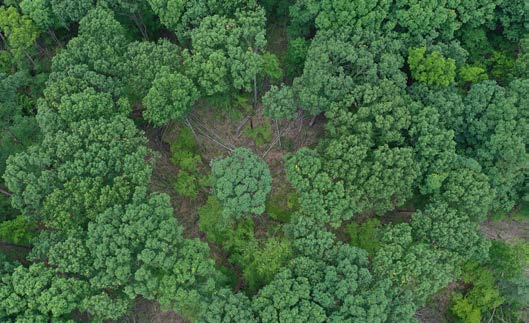
This is a bird’s-eye view of an oak tree that has been crown released. You can see how much more growing room the tree in the middle has compared to other trees in the picture.
Invasive species control
Many invasive species (e.g., bush honeysuckle, multiflora rose, Japanese stiltgrass) do not provide quality forage for deer and other wildlife. In fact, invasive species directly limit the amount and quality of forage and cover found in forested areas. Removing invasive species can create room for native plants, which often provide better forage and cover for a much wider range of wildlife species. Often, planting native plants following invasive removal is not needed because desirable native plants will grow from the seeds left in the soil.
The long-term control of invasive species frequently requires herbicide application. Large infestations of invasives may require mechanical removal through techniques such as forest mulching in addition to herbicide applications. It may take multiple herbicide applications over multiple years to gain the upper hand in controlling invasive species on your property. Be sure to check with your local Extension office or with a forestry or wildlife professional to determine the best control options for the invasive species on your property.
You should control invasive species or have a plan on how you will control invasives before you open up the canopy in your woods.

Controlling invasives like autumn olive, bush honeysuckle, and multiflora rose using mechanical and herbicide applications can help provide growing space for beneficial native plants like blackberry, pokeweed, and greenbrier.
Prescribed Fire
Prescribed fire is a tool that can be used in early successional areas or forested areas to improve the understory vegetation structure and composition. Fire is often the most efficient and effective tool in a manager’s toolbox. Using prescribed fire in a mature closed-canopy forest is not as impactful as using prescribed fire in a stand in which the canopy is open, but it does have benefits. These benefits include reducing the midstory, improving oak regeneration, and increasing the amount of forage available. Mature forest stands that have been burned can produce 2-3 times more forage than a similar stand left unburned.
Be sure to have a prescribed burn plan before implementing prescribed fire. Involving those with experience
is a must when using a prescribed fire as a management tool on your property. For more information about using prescribed fire in the forest, contact a forestry or wildlife professional. If you are interested in hiring a contractor to burn your woods, visit the Indiana Prescribed Fire Council’s website (www.inpfc.org) for a list of prescribed fire contractors.

Prescribed fire, especially when coupled with opening the canopy, can be a great tool to enhance food and cover for white-tailed deer.
Wildlife Retention Cut + Prescribed Fire
Stands in which fire is used following thinning, either as part of a shelterwood harvest or wildlife retention cut, can contain 3-5 times as much forage as stands that are thinned without fire and 3-8 times as much forage as an unthinned and unburned stand. Stands that have been thinned and burned can produce upwards of 1,000 pounds of forage per acre, plus abundant cover for deer.
FOREST STAND IMPROVEMENT
WILDLIFE RETENTION CUT, OR WILDLIFE RETENTION CUT + PRESCRIBED FIRE
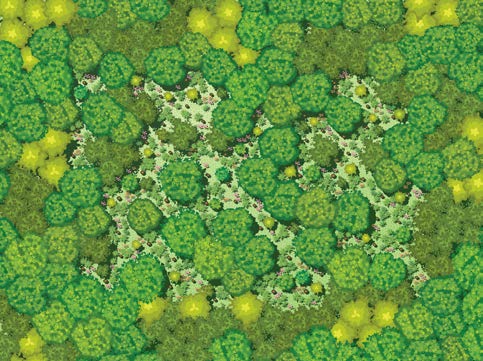 White-Tailed Deer Habitat Benefits
White-Tailed Deer Habitat Benefits
| Deer Forage (lbs per acre)1 |
Overall Benefits |
| 100 - 750 (Wildlife Retention Cut) |
• Increased forage and browse |
| 500 - 1,200 (Wildlife Retention Cut + Prescribed Fire) |
• Increased fawning, escape, and thermal cover |
| Other Wildlife Benefits | Forest Benefits |
| • Creates habitat needed by young forest wildlife (ruffed grouse, American woodcock, blue-winged warbler, whip-poor-will) | • Increases forest plant diversity |
| • Increases forage, browse, and soft mast | • Creates diversity of forest age classes including young forest |
| • Tree tops and downed logs left on site provide cover for wildlife | • Promotes oak regeneration |
| • Retains important mast producing species | • Maintains open oak woods |
| • Snags created provide roosting, nesting, and denning sites for a variety of wildlife species |
|
| • Felled trees provide cover for various wildlife species |
CROWN RELEASE / CROP TREE RELEASE
 White-Tailed Deer Habitat Benefits
White-Tailed Deer Habitat Benefits
| Deer Forage (lbs per acre)1 |
Overall Benefits |
| Not available | • Increased mast production • Increased forage and browse in canopy gaps • Increased cover in canopy gaps |
| Other Wildlife Benefits | Forest Benefits |
| • Increases forage, browse, and soft mast | • Increases growth of residual trees |
| • Tree tops left on site provide cover for wildlife | • Increases mast production |
| • Retains important mast producing species | |
| • Snags created provide roosting, nesting, and denning sites for a variety of wildlife species |
|
| • Felled trees provide cover for various wildlife species |
PRESCRIBED FIRE
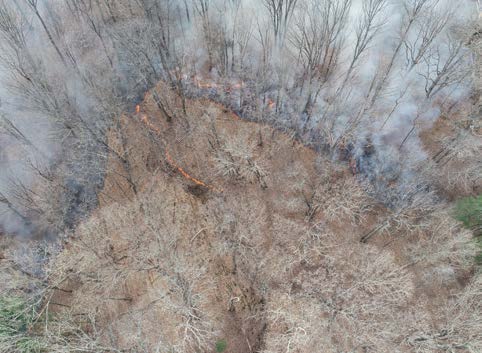 White-Tailed Deer Habitat Benefits
White-Tailed Deer Habitat Benefits
| Deer Forage (lbs per acre)1 |
Overall Benefits |
| 150 - 300 | • Increased forage and browse quantity and quality • Increased fawning, escape, and thermal cover |

| Other Wildlife Benefits | Forest Benefits |
| • Maintain food and cover for wildlife that use early successional plant communities or young forest | • Thins midstory trees to enhance oak regeneration |
| • Increased soft mast production | • Increases plant diversity |
| • Tree tops left of site provide cover for wildlife | • Sets-back or maintains forest succession |
EDGE FEATHERING
 White-Tailed Deer Habitat Benefits
White-Tailed Deer Habitat Benefits
| Deer Forage (lbs per acre)1 |
Overall Benefits |
| Not available | • Increased forage and browse • Increased fawning, escape, and thermal cover |

| Other Wildlife Benefits | Forest Benefits |
| • Creates cover and food for wildlife that use shrubby areas (northern bobwhite, etc.) | • Promotes regeneration of shade-intolerant species |
| • Snags created provide roosting, nesting, and denning sites for a variety of wildlife species | • Can increase plant diversity |
| • Felled trees provide cover for various wildlife species |
Edge feathering
Many landowners may own forested land that adjoins pastures, hayfields, crop fields, wildlife food plots, or other open areas and may be interested in managing those areas for deer. Edge feathering is a technique that can be used to remove the trees from the edge of a crop field, thus eliminating the shade produced by those trees. This is beneficial to deer and other wildlife in that it provides a brushy transition from the field to the forest as opposed to the field abruptly meeting the mature forest. Escape cover, thermal cover, fawning cover, and forage are all provided by areas that have been edge feathered.
Trees within 30-50 ft of the field edge can be harvested, felled, or girdled to create this brushy transition. Stumps and girdles should be treated with an herbicide mixture to limit resprouting. Alternatively, rather than removing trees in the woods, the area of the field adjoining the woods can be allowed to advance through succession to create this brushy transition. A feathered edge can then be maintained with prescribed fire or herbicide to limit woody plant growth.
What About Hinge-Cutting?
Hinge-cutting is a technique that is commonly used by landowners who are interested in managing deer on their property. And while it has its benefits, it is often not necessary or even the best technique to improve deer habitat in your woods. Hinge-cutting refers to cutting a tree partially through so when it falls the tree is still living. The benefits are the instantaneous food and cover created, especially during times of year when food or cover may be most lacking (winter or early spring), and the ability to change deer movement. On the other hand, hinge-cutting can be dangerous, much of the browse produced is too tall for deer, and the living tree tops are still shading the ground. Hinge-cutting is more of a deer management tool than a forest stand improvement tool. As such, it should be used only in specific situations, as opposed to being used broadly across your woods.
A majority of the time you do not need hinge-cut trees to improve food and cover for deer. In fact, cutting the tree down completely (felling) or killing it with herbicide (hack and squirt or girdling) are often better options to improve deer habitat quality or forest stand structure. Some of the advantages to these methods over hinge-cutting are; more sunlight reaches the forest floor allowing herbaceous plants to respond, the forage and browse produced are reachable by deer, and if stump sprouts are produced they are more nutritious than what is produced by the tops of hinge-cut trees.
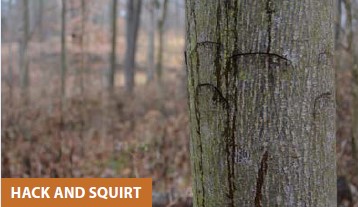


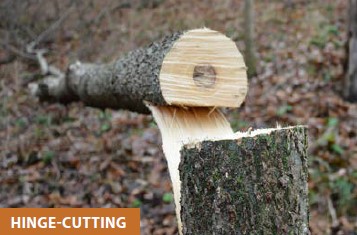
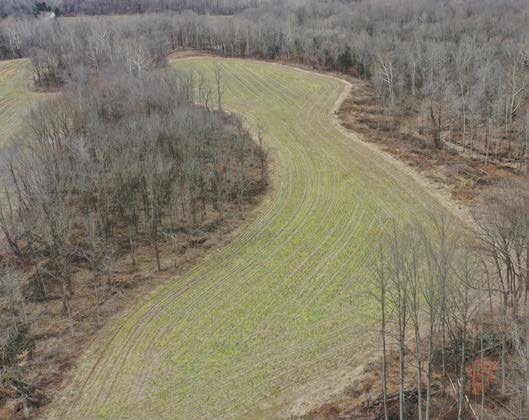
Edge feathering was used around the edge of this crop field to increase food and cover for wildlife.
Conclusion
Managing your woods can improve the quality and quantity of forage and cover available, not only for deer, but for other wildlife. In order to best manage your property, it is important to consider what resources (food, water, cover, space) are available on your property and in the surrounding landscape, and then determine which resources are in short supply. This can help provide clarity as to which management option(s) you should utilize. Managing your woods for deer and other wildlife is a matter of managing sunlight. Allowing more sunlight through the canopy to reach the forest floor provides more forage and cover at the ground level. Ensuring your property provides a mixture of different successional stages and forest ages (both young and mature) creates the optimal habitat for white-tailed deer.
For more resources related to wildlife habitat management visit extension.purdue.edu/pondwildlife.
Acknowledgements
We would like to thank Brian MacGowan, Purdue University, Jordan Nanney, Tennessee Wildlife Resource Agency, Ron Rathfon, Purdue University, and Bronson Strickland, Mississippi State University for improving the quality of this publication. We would also like to thank Dawn Minns for help with publication layout and design. Timber harvest and forest stand improvement graphics were created by Adduci Studios. This publication was funded by a Purdue Extension Issue-based Action Team grant.
Additional Resources
- Brooke, J. M. and C. A. Harper. 2018. Renovating native warm-season grass stands for wildlife: a land manager’s guide. Purdue University Extension. West Lafayette, IN. FNR-548-W.
- Brooke, J. M., P. S. Basinger, J. L. Birckhead, M. A. Lashley, J. M. McCord, J. S. Nanney, and C. A. Harper. 2019. Effects of fertilization and crown release on white oak (Quercus alba) masting and acorn quality. Forest Ecology and Management 433:305–312.
- Harper, C. A. 2019. A guide to wildlife food plots and early successional plants. NOCSO Publishing. Maryville, TN.
- Lashley, M. A., C. A. Harper, G. E. Bates, and P. D. Keyser. 2011. Forage availability for white-tailed deer following silvicultural treatments in hardwood forests. The Journal of Wildlife Management 75:1467–1476.
- Nanney, J. S., C. A. Harper, D. A. Buehler, and G. E. Bates. 2018. Nutritional carrying capacity for cervids following disturbance in hardwood forests. The Journal of Wildlife Management 82:1219–1228.
- Pierce, R. A., E. Flinn, J. Barton, H.E. Stelzer, and J. Dwyer. 2013. Enhancing white-tailed deer habitats on your property: woodlands and forests. University of Missouri Extension. Columbia, MO. G9495.
- Purdue Pesticides Program. Forest Pest Management (e-learning).
- Rathfon, R. and M. R. Saunders. 2019. Forest Improvement Handbook. Purdue University Extension. West Lafayette, IN. FNR-IDNR-414.
Find Out More
The Purdue Extension Education Store offers a variety of publications related to forestry and wildlife management(edustore.purdue.edu)

Renovating native warm season grass stands for wildlife: a land manager’s
guide (FNR-548-W)
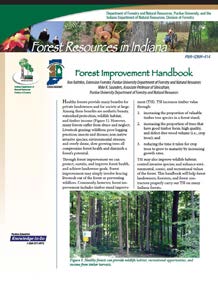
Forest Improvement Handbook (FNR-IDNR-414).
Reference in this publication to any specific commercial product, process, or service, or the use of any trade, firm, or corporation name is for general informational purposes only and does not constitute an endorsement, recommendation, or certification of any kind by Purdue Extension. Individuals using such products assume responsibility for their use in accordance with current directions of the manufacturer.
extension.purdue.edu/pondwildlife
January 2020
Find out more at
THE EDUCATION STORE
edustore.purdue.edu).
